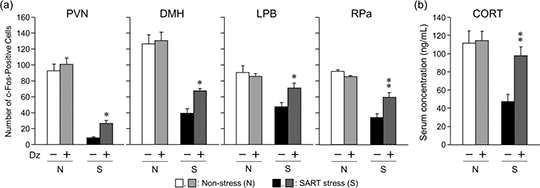Print version
Search Pub Med
Chronic stress attenuates neuronal activity of the brain stress circuit and the function of the hypothalamus-pituitary-adrenal axis in mice A change of ambient temperature causes various symptoms in a body. The specific alternation of rhythm in temperature (SART)-stressed animal which shows various chronic stress symptoms is considered a model for autonomic imbalance (1). The hypothalamus-pituitary-adrenal (HPA) axis plays an important role in stress-related diseases (2). The aim of this study was to investigate the characteristics of the neuronal activity of the brain stress circuit and the function of the HPA axis in SART-stressed mice. Male ddY mice (n=5-8) were administered diazepam (Dz) at 4mg/kg/day, p.o. during SART stress. After the mice were given a 1 hour cold exposure, each mice was deeply anesthetized with isoflurane and intracardially perfused with saline followed by 4% paraformaldehyde in PBS. Brains were removed and processed for immunohistochemistry to count the c-Fos positive cells in the paraventricular hypothalamic nucleus (PVN), dorsomedial hypothalamic nucleus (DMH), lateral parabrachial nucleus (LPB) and raphe pallidus nucleus (RPa) under the stress condition. The c-Fos expression was used as an indicator of neuronal activity. The serum corticosterone (CORT) level was measured by EIA. The serum CORT level and c-Fos expression in PVN, DMH, LPB and RPa were significantly increased by acute cold stress in mice. However, these parameters were unchanged in SART-stressed mice, and kept at the control level. In SART-stressed mice, Dz increased c-Fos expression of 4 areas in the brain (Fig.1a) and serum CORT level 
Fig. 1 Effect of Dz on cold exposure-induced neuronal activity of brain (a) and serum CORT level (b) in SART-stressed mice. p<0.01, p<0.05 v.s. the respective vehicle group (Tukey’s test). In summary, stress response to acute cold stress was supressed in SART-stressed mice. It was considered that this abnormal response was related to autonomic imbalance and chronic stress symptoms, because Dz improved the decreased serum CORT level and neuronal activity of PVN which is the starting point in the HPA axis. These results suggest that the SART stress supressed the function of the HPA axis via brain stress response. (1) Hata T, Kita T, Itoh E, et al. (1983) Jpn J Psychosom Med 23: 61-68. (2) Bosch OG, Seifritz E, Wetter TC. (2012) World J Biol Psychiatry 13: 556-568 |


 s (Fig. 1b).
s (Fig. 1b).